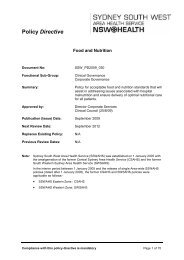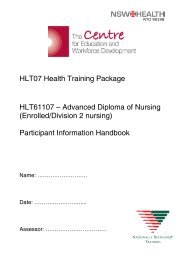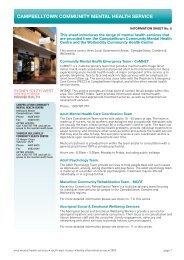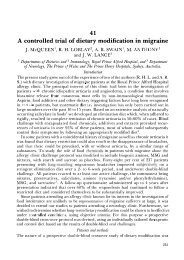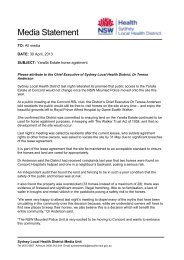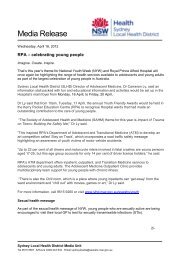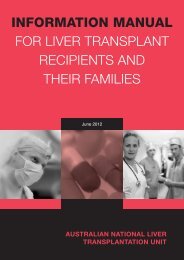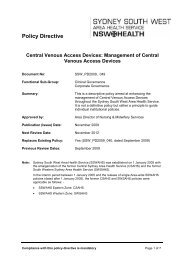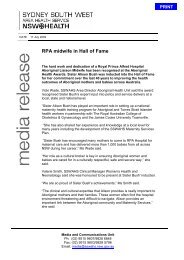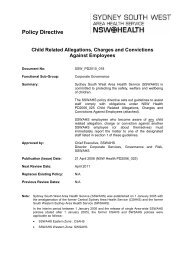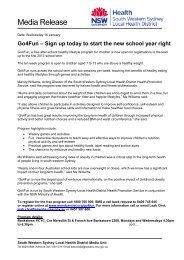Aged Care & Rehabilitation Clinical Services Plan 2007 – 2012
Aged Care & Rehabilitation Clinical Services Plan 2007 – 2012
Aged Care & Rehabilitation Clinical Services Plan 2007 – 2012
Create successful ePaper yourself
Turn your PDF publications into a flip-book with our unique Google optimized e-Paper software.
<strong>Aged</strong> <strong>Care</strong> & <strong>Rehabilitation</strong> <strong>Clinical</strong> Service <strong>Plan</strong> <strong>2007</strong> - <strong>2012</strong>meet the growing demand for equipment, as well as the increasing costs of purchasing equipment,particularly as technical specialisation continues. Expansion must include sufficient resources forthe maintenance and monitoring of equipment.8.4.2 HydrotherapyHydrotherapy is a key component of the rehabilitation plan for many patients. Access tohydrotherapy is especially important in relation to the increase in arthritic and musculoskeletalconditions particularly associated with the older population. Hydrotherapy pools are located atRPAH and Canterbury Hospital only. Given the infrastructure and maintenance cost of providinghydrotherapy services on site and the ability to access services elsewhere, it is most appropriate thatresources are available to access hydrotherapy off-site. Significant work by Allied Health and<strong>Rehabilitation</strong> services will be required to develop and implement effective systems to enable this tooccur.8.4.3 Orthotics ClinicsOrthotics involves the fitting of appliances which are generally special braces/aids designed tosupport, control, protect or improve the function of the body affected by injury or disease. Educationand support is also provided to patients and their families on the use, management and maintenanceof the orthosis. The majority of clients access orthotics services for post operative care, rehabilitationor sports medicine. Paediatric and <strong>Aged</strong> <strong>Care</strong> patients are the most common.Orthotics services are managed by Allied Health in the east of the Area (based at RPAH), with aprivate service only available in the south west, creating inequity across the Area.Demand for orthotics services across the Area is likely to increase in line with population growth, theageing of the population and the increasing prevalence of disability. Further investigation is requiredto determine the likely future activity and most appropriate locations and models for the delivery ofservices.8.4.4 Seating ClinicsSpecialised seating is required by a number of patients with a disability, including people withcomplex disabilities and those who are wheelchair dependent.A seating clinic is provided at Liverpool Hospital through the Occupational Therapy Department.This is the only seating clinic available in the Area.Further investigation is required to determine the likely future demand for this service type and todetermine the most appropriate locations for the delivery of services.8.4.5 ProstheticsProsthetics is a multidisciplinary service for amputees, which involves the fitting of custom madeprostheses which are designed to both look and function as near as is practicable, to the originallimb. Clients are referred to prosthetic services by <strong>Rehabilitation</strong> Specialists, usually through theinpatient setting or outpatient amputee clinics. A prosthetic service provides assessment for thefitting of a prosthesis, makes and fits the prosthesis, and undertakes all requisite maintenance. Theservice provides advice, education and support to patients and their families, on the rehabilitationprocess and living with a prosthesis.At present prosthetics services across NSW are delivered by a combination of publicphysiotherapists and private prosthetists, making interim prostheses; with private prosthetistsmaking all definitive prostheses under the auspices of the Artificial Limb Service of NSW (ALS). Themodel of care being proposed and developed will involve joint funding between the ALS and NSWHealth/Area Health <strong>Services</strong>, with the ALS covering the cost of components and AHSs coveringstaffing and associated costs.As demand for these services continues to grow as a result of increasing rates of peripheral vasculardisease, diabetes and some other chronic diseases, there will be a need to develop additionalamputee and prosthetic services.Page 64




